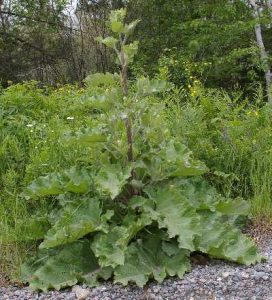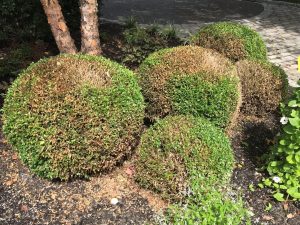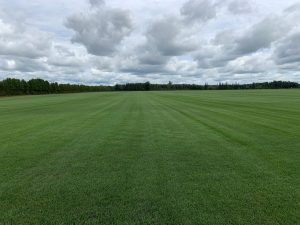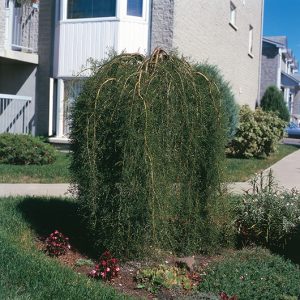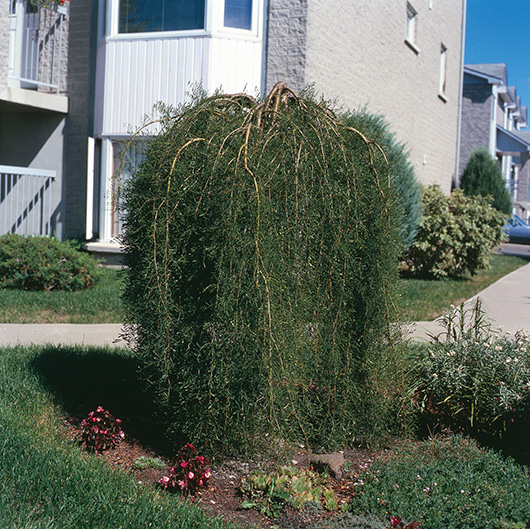
Hi, Dave here from Foxy Gardens in southwestern Ontario. In the quiet gardens and carefully designed landscapes of Southern Ontario, the graceful form of the Weeping Pea Tree—also known as Walker’s Weeping Peashrub—is a common sight.
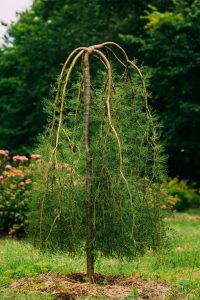
With its drooping branches, airy foliage, and yellow springtime flowers, this tree adds a unique architectural elegance to any space. But as more homeowners turn toward native gardening practices and environmental stewardship, one question frequently arises:
Is the Weeping Pea Tree actually native to Southern Ontario?
The short answer is no—but the full story is more nuanced, and understanding the origins, benefits, and ecological impact of this tree can help gardeners make more informed planting choices.
What Is the Weeping Pea Tree?
The Weeping Pea Tree (Caragana arborescens ‘Walker’) is a cultivated variety of the Siberian Peashrub (Caragana arborescens). It’s valued for its dramatic weeping shape, fine-textured leaves, and compact size.
Typically grafted onto a standard trunk, the weeping form cascades downward in a fountain-like manner, making it a standout focal point in yards, gardens, and urban landscaping.
In spring, the tree produces clusters of small, yellow, pea-like flowers, followed by seed pods in late summer. It’s drought-tolerant, cold-hardy, and deer-resistant—qualities that make it particularly appealing in Ontario’s variable climate.
But while it thrives in Southern Ontario landscapes, it didn’t originate here.
Native vs. Cultivated: What’s the Difference?
To understand whether a plant is native, we need to define what “native” means in ecological terms. A native plant is one that has evolved over thousands of years in a particular region, adapting to the local climate, soil, pollinators, and wildlife. Native plants play a key role in supporting local ecosystems, including insects, birds, and mammals that rely on them for food and shelter.
The Weeping Pea Tree is not a naturally occurring species. It is a cultivar—short for “cultivated variety”—bred by horticulturists for ornamental purposes. The species it comes from (Caragana arborescens) is native to the cold steppes of eastern Europe and Siberia, not to North America.
In short, while the species may be naturalized in some areas of Canada, the weeping form ‘Walker’ is a man-made cultivar introduced and popularized through horticultural trade.
Where Does It Come From?
The parent species, Caragana arborescens, also known as the Siberian Peashrub, hails from Eurasia, particularly the rugged regions of Siberia and Mongolia. It was introduced to North America in the 1800s, primarily for use as a windbreak, erosion control, and drought-tolerant hedging plant in the Canadian Prairies.
Its resilience made it a favorite among homesteaders and rural property owners in open, wind-prone regions.
The weeping cultivar ‘Walker’ was developed much later as a grafted ornamental tree—selected specifically for its aesthetic appeal rather than its utility. It’s not found in the wild in its weeping form but is widely sold at nurseries throughout Southern Ontario and other regions.
Popularity in Southern Ontario Landscapes
Gardeners in Southern Ontario are drawn to the Weeping Pea Tree for several reasons:
-
Visual interest: Its umbrella-like canopy provides a striking silhouette, even in winter.
-
Low maintenance: Once established, it needs little care beyond the occasional prune.
-
Cold hardy: It can tolerate the fluctuating temperatures of the region, from icy winters to hot summers.
-
Pest resistance: Few local pests or diseases trouble this tree.
-
Soil tolerance: It adapts well to a variety of soil types, including poor or sandy soils.
Because of these traits, it’s commonly used as a specimen tree in front yards, near patios, or in rock gardens.
Can It Be Invasive?
Here’s where things get complicated. While the Weeping Pea Tree cultivar itself is unlikely to spread aggressively due to its grafted and sterile nature, the species it comes from—Caragana arborescens—can escape cultivation and naturalize in the wild.
In provinces like Alberta, the Siberian Peashrub has shown invasive tendencies. It spreads quickly, especially in disturbed areas or dry prairie environments, and outcompetes native seedlings, which can lead to a decline in local plant diversity.
In Southern Ontario, this risk is lower due to the region’s more forested, humid environment. However, if conditions allow, the species can still self-seed and potentially displace native undergrowth.
So while the weeping cultivar is generally safe, gardeners should be cautious when planting non-native shrubs from species known to have invasive potential elsewhere.
Native Alternatives to Consider
If you love the shape and texture of the Weeping Pea Tree but want to support Ontario’s native biodiversity, consider planting one of the following alternatives:
1. Serviceberry (Amelanchier alnifolia)
-
A beautiful small native tree with delicate white flowers in spring and edible purple berries.
-
Provides food for birds and pollinators.
-
Offers multi-season interest with colorful fall foliage.
2. Pagoda Dogwood (Cornus alternifolia)
-
A graceful native understory tree with tiered horizontal branching.
-
Flowers attract pollinators and fruits feed birds.
-
Great for shade or partial sun.
3. Fringe Tree (Chionanthus virginicus)
-
While native to the eastern U.S., it’s hardy in parts of Southern Ontario.
-
Features beautiful white fringe-like blooms in spring.
-
Slow-growing and adaptable to various soil types.
The Bottom Line: Not Native, But Not Evil
The Weeping Pea Tree is not native to Southern Ontario, nor to any part of North America. It’s a cultivated form of a Eurasian species that’s valued for its ornamental charm and resilience in difficult growing conditions.
In general, it’s not considered highly invasive in Ontario, but gardeners should remain ecologically aware, especially when choosing landscaping plants near naturalized or wild areas.
By understanding where our plants come from and how they interact with the environment, we can make better decisions that balance beauty, function, and ecological health.
Final Thought
Whether you’re a homeowner designing a front yard or a landscape professional working with clients, it pays to ask: Is this plant just pretty—or is it also sustainable? The Weeping Pea Tree is a lovely addition to a cultivated garden, but it’s important to plant with knowledge and responsibility.

